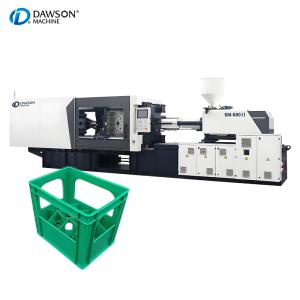Plastic Beer Baskets and Boxes: Crafted by Injection Molding
Machines
In the realm of packaging, plastic beer baskets and boxes have
become indispensable companions for brewers, distributors, and
consumers alike. Behind their seamless production lies a workhorse
of manufacturing: the injection molding machine. This sophisticated
equipment has revolutionized the way these essential containers are
made, offering efficiency, precision, and versatility that
traditional methods simply cannot match.
Injection molding machines operate on a straightforward yet
ingenious principle. The process begins with the feeding of plastic
resin pellets into a heated barrel. As the pellets move through the
barrel via a rotating screw, they are subjected to intense heat,
melting into a molten state. Once the molten plastic reaches the
desired consistency, the screw acts as a plunger, forcing the
material into a tightly closed mold cavity that mirrors the shape
of the beer basket or box. The mold, typically made from high-grade
steel, is cooled rapidly, causing the plastic to solidify and take
on the exact form of the cavity. After a brief cooling period, the
mold opens, and the newly formed plastic part is ejected, ready for
further processing or immediate use.
One of the key advantages of using injection molding machines for
producing plastic beer baskets and boxes is the exceptional
precision they offer. The molds are engineered with intricate
details, ensuring that each container meets strict dimensional
specifications. This precision is crucial for beer baskets and
boxes, as they need to securely hold bottles or cans, preventing
damage during transportation and storage. Whether it’s the evenly
spaced dividers in a beer basket or the reinforced edges of a beer
box, injection molding guarantees consistency across every unit
produced, eliminating the variability that can plague other
manufacturing techniques.
Efficiency is another hallmark of injection molding in this
context. These machines can produce large volumes of beer baskets
and boxes in a relatively short time. The cycle time – the time it
takes to complete one full production cycle from feeding the resin
to ejecting the finished part – is often measured in seconds,
depending on the size and complexity of the container. This high
production rate makes injection molding ideal for meeting the
demands of large-scale beer production and distribution, where
timely and cost-effective packaging is essential. Additionally, the
automated nature of modern injection molding machines reduces the
need for manual labor, minimizing the risk of human error and
further enhancing efficiency.
Versatility in material selection is yet another benefit. Injection
molding machines can work with a wide range of plastic materials,
each offering unique properties that can be tailored to the
specific needs of beer packaging. Polypropylene (PP) is a popular
choice due to its lightweight nature, excellent impact resistance,
and ability to withstand low temperatures – important qualities for
keeping beer cool during transport. High-density polyethylene
(HDPE) is another common option, valued for its durability,
chemical resistance, and flexibility. Manufacturers can also blend
different plastics or add additives to enhance characteristics such
as UV resistance, strength, or recyclability, ensuring that the
beer baskets and boxes meet both functional and environmental
requirements.
The design possibilities afforded by injection molding are
virtually limitless, allowing for innovative and functional beer
packaging solutions. Brewers and packaging designers can
collaborate to create custom shapes, sizes, and features that not
only protect the product but also serve as a marketing tool. For
example, beer baskets can be designed with handles for easy
carrying, while beer boxes can incorporate interlocking mechanisms
to stack securely, saving space in warehouses and delivery trucks.
Logos, brand names, or decorative patterns can be seamlessly
integrated into the mold, eliminating the need for secondary
printing or labeling processes and giving the packaging a polished,
professional look.
Sustainability is an increasingly important consideration in modern
manufacturing, and injection molding machines are rising to the
challenge. Many plastic resins used in the process are recyclable,
and advancements in technology have made it possible to incorporate
recycled materials into the production of beer baskets and boxes
without compromising their quality. Additionally, the efficiency of
injection molding reduces material waste, as the molten plastic is
precisely measured and only the amount needed to fill the mold is
used. Some machines are also equipped with energy-saving features,
such as variable speed drives and efficient heating systems,
minimizing their environmental footprint.
The durability of plastic beer baskets and boxes produced by
injection molding is a significant advantage in the harsh
conditions of the supply chain. These containers are designed to
withstand repeated use, making them a cost-effective and
eco-friendly alternative to single-use packaging. Whether they’re
being loaded onto trucks, stacked in warehouses, or handled by
consumers, they maintain their structural integrity, ensuring that
the beer inside remains safe and intact. This reusability not only
reduces packaging waste but also lowers long-term costs for
breweries and distributors.
In conclusion, injection molding machines have become the backbone
of producing high-quality plastic beer baskets and boxes. Their
ability to deliver precision, efficiency, versatility, and
sustainability makes them an ideal choice for meeting the demands
of the beer industry. From the intricate details of the mold to the
selection of the perfect plastic material, every aspect of the
injection molding process is geared towards creating packaging that
is both functional and appealing. As the beer industry continues to
evolve, injection molding technology will undoubtedly play a
crucial role in shaping the future of beer packaging, offering
innovative solutions that meet the needs of manufacturers,
distributors, and consumers alike.


